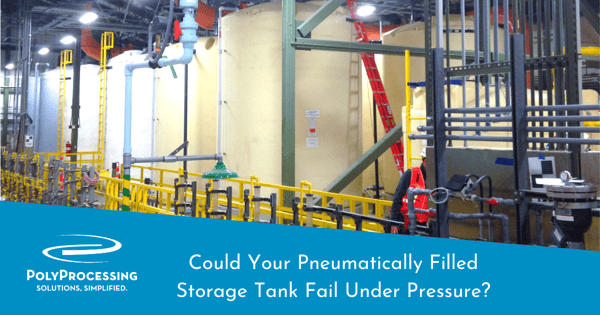Could Your Pneumatically Filled Storage Tank Fail Under Pressure?
Polyethylene chemical storage tanks are designed to expand and contract slightly in response to changes in temperature and internal pressure. But if your tank isn’t designed to handle the pressure it faces at key moments, you could be unknowingly setting yourself up for a tank failure.

Typically, bulk chemical storage tanks are filled in three different ways. One option is by mechanical pump. A second option is by gravity, as in the case of leachate and condensate flowing out of a landfill basin into a storage tank. Each of these techniques creates little to no additional pressure inside the storage tank as it’s filled.
The third and most common method for filling chemical storage tanks is pneumatic filling. With a pneumatic fill system, air pressure is used from the tank truck to blow the chemicals into the bulk chemical storage tank. This technique of pressurized offloading from the truck into the storage tank saves filling time.
However, when you pneumatically fill a polyethylene storage tank, you also create additional pressure that builds up inside the storage tank. Pneumatically filled chemical storage tanks have the potential for becoming over-pressurized as air builds up in the tank. Over-pressurizing a polyethylene storage tank through repeated fill cycles can damage and weaken the tank sidewalls, resulting in stress cracks and premature tank failure.
Performance Under Pressure
Alleviating the pressure in the pneumatically filled storage tank requires a superior solution than venting systems that are designed for day-to-day tank operations. Instead, you need specially engineered vents and manway covers that are designed to handle the sudden and forceful pressure that pneumatic filling places on a chemical storage tank.
At Poly Processing, we noticed a great deal of damage to tanks from over pressurization. So we commissioned a third-party engineering firm to study the impact of pressure on pneumatically filled chemical storage tanks due to different applications or settings. The prevailing industry standard regarding venting was to use a vent one inch larger than the fill line — for example, a two-inch fill line requires a three-inch vent.
The commissioned study determined the standard to be adequate for mechanical filling, but not for pneumatically filled tanks. As the rate of pumping increases, so does the chance for a surge of pressurized air entering the tank. This can result in over pressurization if your tank is using standard venting.
As a result of this study, the thinking in the market shifted. Now the standard for proper vent size in pneumatically loaded polyethylene tanks is double the size of the fill — for example, a two-inch fill line requires a four-inch vent. This allows the air to evacuate at a faster rate, reducing the risk of over pressurization.
The Best Vents for Pneumatically Filled Tanks
Either the Safe Surge® or FS 2650® is the right vent for all pneumatically filled chemical storage tanks. The Safe Surge is an emergency pressure release lid that’s designed only to come into play during an event that could damage the polyethylene tank. It works by actuating a weighted lid on a swing arm when air pressure surges beyond .25 PSI and the primary vent can no longer adequately handle the ACFM rate. This ensures atmospheric pressure is maintained at all times.
For chemical storage tanks located outdoors where fumes are not a concern, the F.S. 2650 Manway Cover is the less expensive option for safely handling any air pressure surges. This combines a vent and manway cover into one engineered lid system that can evacuate air volumes up to 2650 ACFM, which is well within the calculated maximum potential pressure surges resulting using both 2 and 3 inch fill lines.
Other Pressurization Considerations
In addition to proper venting systems, your polyethylene tank will need to have the right expansion joints and fittings. Flexible expansion joints and hoses expand freely during loading and unloading to accommodate the storage tank as it expands and contracts from the loading pressure, further protecting the tank against damage.
Contact a Poly Processing storage system specialist to learn more about equipping a pneumatic filled bulk storage tank.
- January 25, 2021
- Topics: Venting
About Poly Processing
Posts By Topic
Tech Talk Podcast Episodes
Subscribe By Email
Recent Posts
- Maximizing Fill Efficiency: Selecting the Optimal Fill Line System
- Chemical Storage Tanks: A Quick Guide for End Users
- Popular Customization Options for Chemical Storage Tanks
- Understanding Flood Zones Under the IBC: Building Requirements and Insurance Implications
- Choosing Between Steel, Polyethylene, and Fiberglass Tanks: What You Need to Know
Tank Configurator

Find the recommended tank and system components for your chemical storage challenge.
Configure a Tank Package





